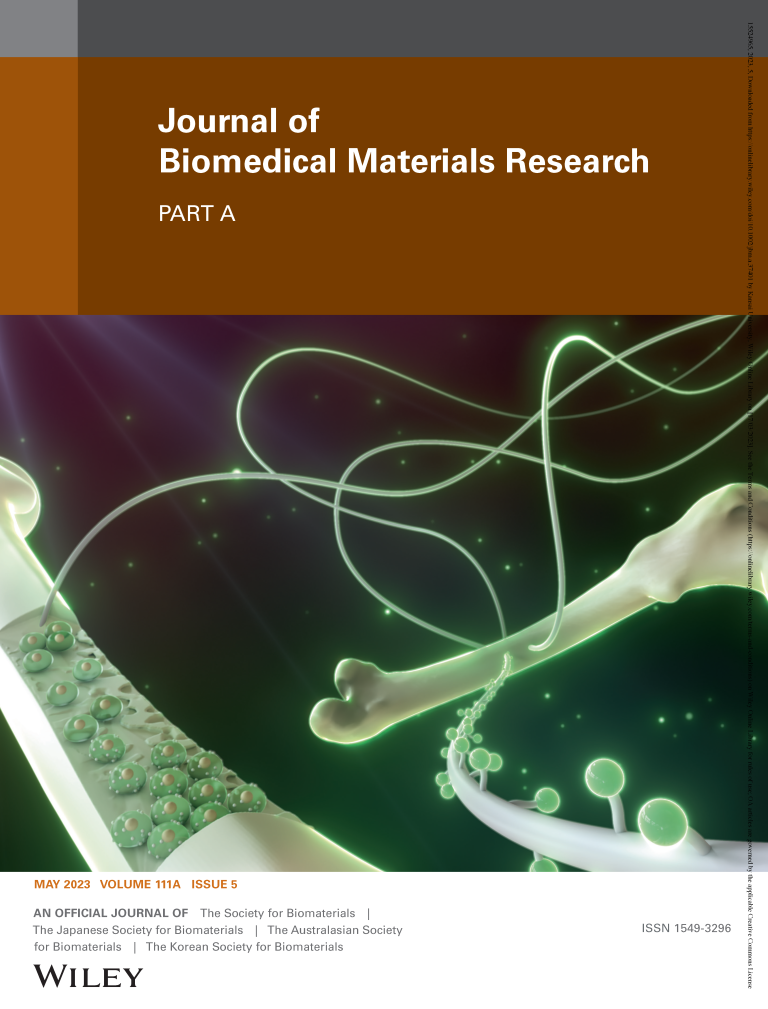論文雑誌「Journal of Biomedical Materials Research Part A」のカバーピクチャーを制作しました[関西大学]
弊社で制作しました関西大学 岩崎泰彦先生ご依頼のカバーアートが
Wiley社が発行する学術雑誌 Journal of Biomedical Materials Research Part A
2023年5月号に採用されました。

Client
関西大学
化学生命工学部 化学・物質工学科
岩崎泰彦先生
化学生命工学部 化学・物質工学科
岩崎泰彦先生
Journal
Journal of Biomedical Materials Research Part A
May 2023, Volume111, Issue5 Link
May 2023, Volume111, Issue5 Link
Bone-targeting polyphosphodiesters that promote osteoblastic differentiation
Kenjiro Kiyono, Shun Mabuchi, Akihisa Otaka, Yasuhiko Iwasaki
Polymers for pharmaceutical use have been attractive in medical treatments because of the conjugation of multifunctional components and their long circulation time in the blood stream. Bone-targeted drug delivery systems are also no exceptional, and several polymers have been proposed for the treatment of bone diseases, such as cancer metastasis and osteoporosis. Herein, we report that polyphosphodiesters (PPDEs) have a potential to enhance osteoblastic differentiation, and they have a targeting ability to bone tissues in vivo. Two types of PPDEs, poly (ethylene sodium phosphate) (PEP•Na) and poly (propylene sodium phosphate) (PPP•Na), have been synthesized. Regardless of the alkylene structure in the main chain of PPDEs, the gene expression of osteoblast-specific transcription factors and differentiation markers of mouse osteoblastic-like cells (MC3T3-E1 cells) cultured in a differentiation medium was significantly upregulated by the addition of PPDEs. Moreover, it was also clarified that the signaling pathway related to cytoplasmic calcium ions was activated by PPDEs. The mineralization of MC3T3-E1 cells has a similar trend with its gene expression and is synergistically enhanced by PPDEs with β-glycerophosphate. The biodistribution of fluorescence-labeled PPDEs was also determined after intravenous injection in mice. PPDEs accumulated well in the bone through the blood stream, whereas polyphosphotriesters (PPTEs) tended to be excreted from the kidneys. Hydrophilic PEP•Na showed a superior bone affinity as compared with PPP•Na. PPDEs could be candidate polymers for the restoration of bone remodeling and bone-targeting drug delivery platforms.
Kenjiro Kiyono, Shun Mabuchi, Akihisa Otaka, Yasuhiko Iwasaki
Polymers for pharmaceutical use have been attractive in medical treatments because of the conjugation of multifunctional components and their long circulation time in the blood stream. Bone-targeted drug delivery systems are also no exceptional, and several polymers have been proposed for the treatment of bone diseases, such as cancer metastasis and osteoporosis. Herein, we report that polyphosphodiesters (PPDEs) have a potential to enhance osteoblastic differentiation, and they have a targeting ability to bone tissues in vivo. Two types of PPDEs, poly (ethylene sodium phosphate) (PEP•Na) and poly (propylene sodium phosphate) (PPP•Na), have been synthesized. Regardless of the alkylene structure in the main chain of PPDEs, the gene expression of osteoblast-specific transcription factors and differentiation markers of mouse osteoblastic-like cells (MC3T3-E1 cells) cultured in a differentiation medium was significantly upregulated by the addition of PPDEs. Moreover, it was also clarified that the signaling pathway related to cytoplasmic calcium ions was activated by PPDEs. The mineralization of MC3T3-E1 cells has a similar trend with its gene expression and is synergistically enhanced by PPDEs with β-glycerophosphate. The biodistribution of fluorescence-labeled PPDEs was also determined after intravenous injection in mice. PPDEs accumulated well in the bone through the blood stream, whereas polyphosphotriesters (PPTEs) tended to be excreted from the kidneys. Hydrophilic PEP•Na showed a superior bone affinity as compared with PPP•Na. PPDEs could be candidate polymers for the restoration of bone remodeling and bone-targeting drug delivery platforms.
